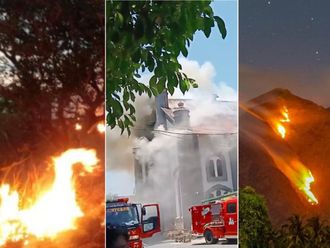Manila: Tropical depression ‘Josie’ made landfall in the northern Luzon provinces of the Philippines, with the storm lashing Batanes, Northern Cagayan, the Babuyan group of islands, Ilocos Norte, the northern part of Ilocos Sur, Apayao and the northern parts of Abra.
“Storm signal No 1 is up in these areas, including Cordillera, Zambales, Tarkac and Nueva Ecija,” Nico Peñaranda, a forecaster at the Philippine Atmospheric, Geophysical and Astronomical Services Administration (Pagasa), said in a television broadcast by GMA News.
The rains have been worsened by the effects of the north-eastern monsoons that affect the country from July to August.
There was little respite for the northern Philippines as two other weather disturbances, tropical storms ‘Inday’ and ‘Henry’ (international names: Ampil and Son-Tinh) passed through the same areas over the last six days.
In Metro Manila, and Central and Southern Luzon, daily rains varying in intensity — from moderate to heavy — resulted in the cancellation of classes and the stopping of work at government offices last Tuesday and Thursday
In Dagupan City, Pangasinan, authorities placed the area under a state of emergency due to the floods.
The flooding was worsened after dams released water brought in by the heavy rains. Some roads in the affected regions were not passable due to the floods.
According to the provincial Disaster Risk Reduction and Management Council, nearly one hundred villages in 14 towns and cities have been flooded since Thursday.
In Marilao and Meycauayan, in the province of Bulacan in central Luzon, unrelenting rains caused flooding which was worsened by the high tide.
So far, there had been no official reports of casualties, but flooding in the affected areas ranges from knee-deep to up to a metre and a half.
The Department of Social Welfare and Development said 46,934 families or 190,295 persons have been affected by the heavy south-west monsoon rains in the Central Luzon region, Calabarzon and Mimaropa.
Some 152 houses were reported damaged in the three regions.
Health Secretary Francisco T. Duque III reminded people in the flooded areas to guard against leptospirosis, a water-borne disease prevalent during the wet season when people are forced to wade through floodwaters.
From January 1 to July 3, 2018, a total of 368 leptospirosis cases were recorded, with 52 deaths reported in Metro Manila.
The rise in cases led Duque to declare a leptospirosis outbreak in the national capital region.
Leptospirosis, which affects a victim’s renal system, can pass into a victim’s body through an open wound exposed to floodwaters contaminated with urine from animals such as rats and other mammals.












